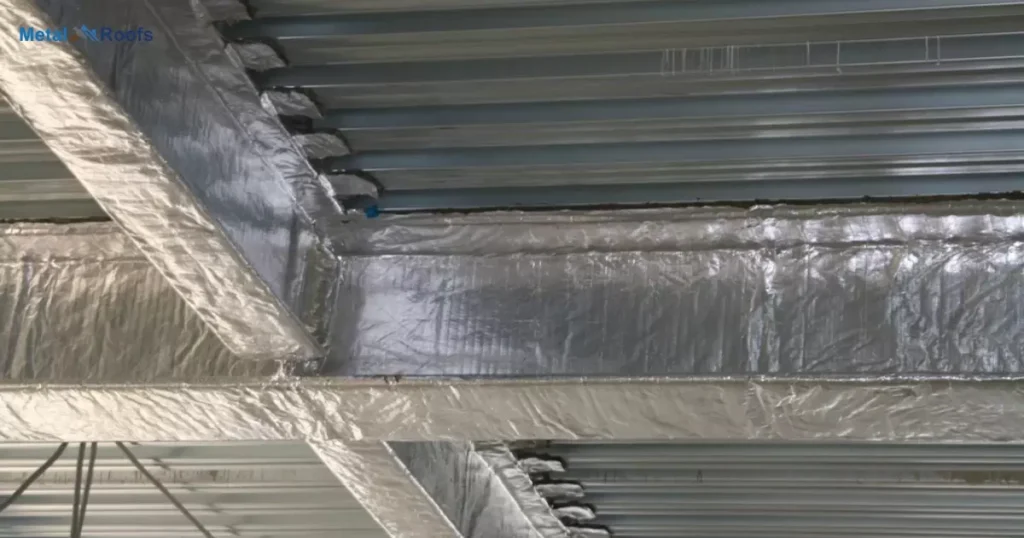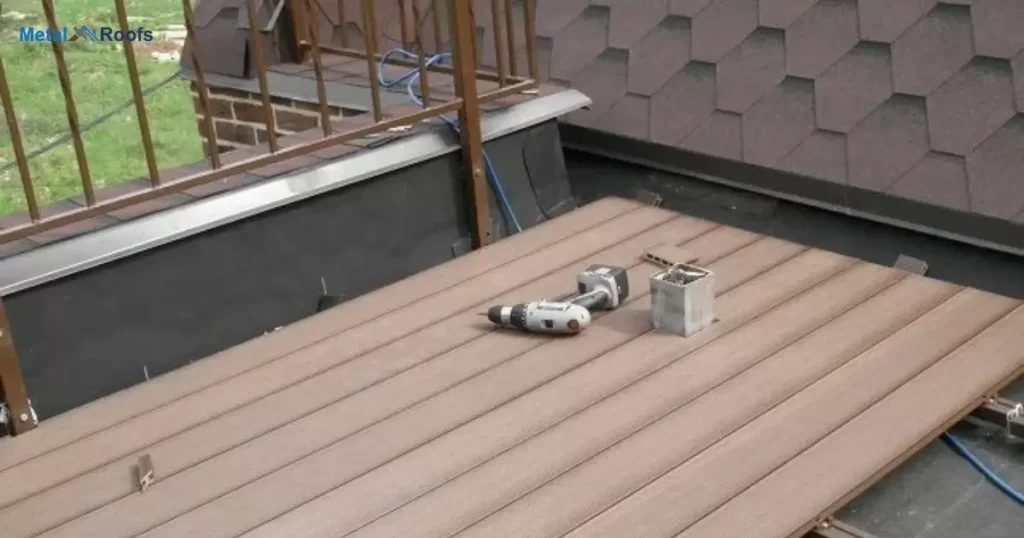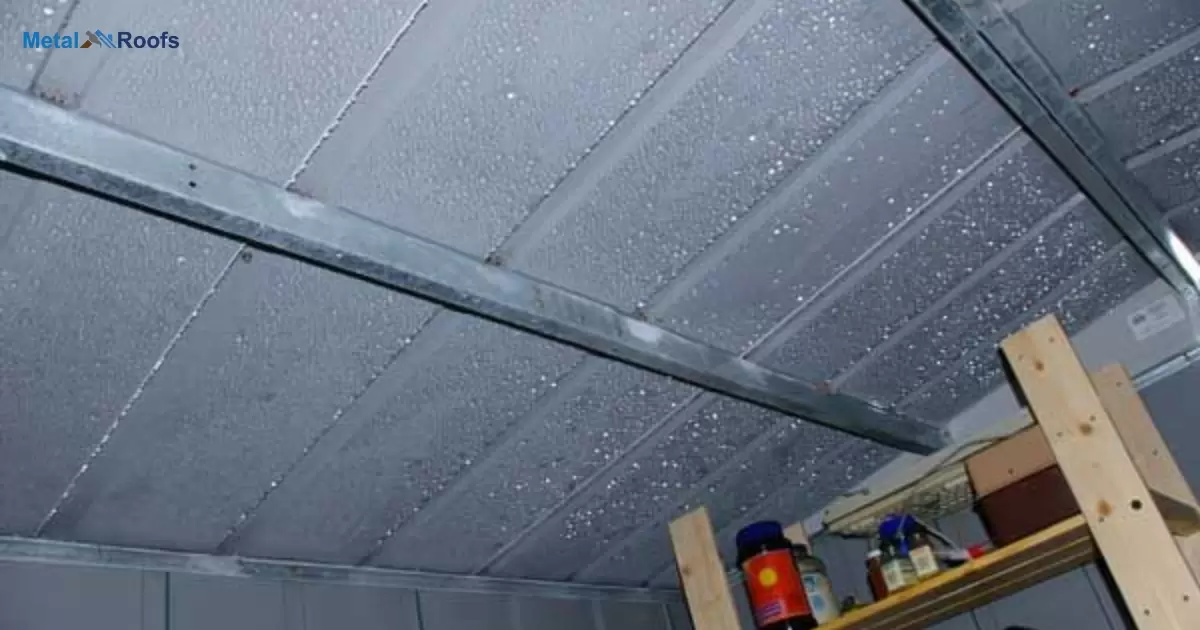stop condensation on a metal roof, add insulation and improve ventilation. Use a vapor barrier to block moisture. Seal gaps and leaks to keep air from escaping. Finally, control indoor humidity to reduce condensation and keep your roof in good shape.
Dealing with condensation on a metal roof can be tricky. How do you stop condensation on a metal roof? You can solve it with simple steps like insulation and better ventilation. Keep your roof dry and effective with these easy solutions.
To prevent condensation on a metal roof, focus on insulation, ventilation, and moisture control. Also, ensure the minimum pitch on a metal roof for proper water drainage. These steps keep your roof dry and efficient over time.
Key Takeaways
- Install vents (ridge, soffit, or gable) to allow moist air to escape.
- Use Vapor Barriers: Place plastic or foil sheets under the roof to block moisture.
- Seal Gaps and Leaks: Close any gaps, cracks, or leaks to prevent moist air from entering.
- Install a Dehumidifier: Use a dehumidifier to lower indoor moisture levels.
Condensation On Steel Roof
Condensation on a steel roof can cause problems. To stop this, insulate the roof. Use materials like spray foam or rigid foam boards. These keep the roof’s temperature steady. This helps reduce moisture buildup.
Good ventilation is key. Install vents to let moist air escape. Ridge vents and soffit vents work well. Seal any gaps or leaks in the roof. A dehumidifier inside can also help. Keep indoor temperatures steady to prevent condensation.
Stop Metal Roof Condensation
To stop condensation on a metal roof, start with insulation. Use spray foam or fiberglass batts to keep temperatures balanced. Good ventilation helps too. Install ridge or soffit vents to let moist air escape. Vapor barriers are also key. Plastic sheets under the roof block moisture.
Seal any gaps or leaks in the roof. This keeps moist air out. A dehumidifier can help lower indoor moisture. Keep the indoor temperature steady with heating or cooling systems. These steps will reduce condensation and protect your metal roof.
Preventing Condensation On Metal Roof
Preventing condensation on a metal roof needs a few steps. First, insulate the roof well. Use materials like spray foam or rigid foam boards. Good insulation keeps temperatures steady. Next, improve ventilation. Install vents at the eaves and ridge to let moist air out.
Use vapor barriers to block moisture. Place plastic or foil sheets under the roof. Seal any gaps and leaks to stop moist air from entering. Install a dehumidifier to lower indoor moisture. Keep indoor temperatures steady with heating or cooling systems. These steps help keep your metal roof dry.
Metal Roof Condensation In Attic

Metal roof condensation in the attic can cause problems. Insulating the roof is a good first step. It keeps temperatures steady and reduces moisture. Improve ventilation by adding vents at the eaves and ridge. This allows moist air to escape.
Use vapor barriers to block moisture. These barriers go under the roof. Seal any gaps and leaks to stop moist air from getting in. A dehumidifier can help by lowering indoor moisture. Keep the attic at a steady temperature to prevent condensation.
Metal Roof Condensation Problems
Condensation can be a big issue with metal roofs. Warm, moist air from inside the building meets the cool metal surface. This causes water droplets to form on the roof. Over time, this can lead to rust and damage.
To fix condensation, you need to insulate and ventilate properly. Adding a vapor barrier can also help. Sealing leaks and using a dehumidifier can prevent future problems. Keeping the indoor temperature steady will also make a difference.
Paint To Stop Condensation On Metal Roof
Special paint can help stop condensation on a metal roof. Look for paint that has insulating properties or reflective coatings. This paint helps keep the roof cooler and reduces moisture buildup. It creates a barrier that keeps warm air from reaching the cool metal.
Apply the paint according to the instructions for best results. Make sure the roof is clean and dry before painting. Repaint as needed to maintain effectiveness. This method is an easy way to manage condensation and extend your roof’s life.
Stop Condensation On A Metal Roof In Winter
To stop condensation on a metal roof in winter, start by insulating the roof. Use materials like spray foam or fiberglass to keep temperatures balanced. Next, improve ventilation with vents at the roof’s edges and peak to let moist air escape. Install vapor barriers under the roof to block moisture from getting to the metal.
Seal any gaps or leaks in the roof and walls to stop moist air from coming inside. Use a dehumidifier inside to lower overall moisture levels. Finally, keep indoor temperatures steady using heating or cooling systems to prevent condensation buildup.
Metal Roof Condensation Barrier

A metal roof condensation barrier prevents moisture from building up. It keeps the underside of the roof from getting damp. Insulation is the first step in adding a barrier. It helps balance the temperature and stops condensation.
Adding a vapor barrier is another key step. It goes under the roof to block moisture. Good ventilation also helps by letting moist air escape. Keeping these elements in place will reduce condensation problems.
Water Dripping From Metal Roof
Water dripping from a metal roof can be a sign of problems. Condensation happens when warm air meets the cold metal. Check for gaps or leaks in the roof. Also, make sure there is enough insulation and ventilation.
To fix the issue, start by sealing any leaks. Adding insulation can help balance the temperature. Good ventilation can prevent moisture build-up. Installing a dehumidifier might also help reduce the dripping.
Stop Condensation On Metal Shed Roof
To stop condensation on a metal shed roof, start with good insulation. Use foam boards or spray foam to keep the temperature steady. Add ventilation to let air move through the shed. Install vents at the roof and eaves to let out moist air.
Use a vapor barrier under the roof to block moisture. Seal any gaps or leaks where air or water can enter. Consider using a dehumidifier to reduce moisture inside. Keeping the temperature stable also helps control condensation.
How To Prevent Condensation On Metal Roofs?

To prevent condensation on metal roofs, start with proper insulation. Insulation keeps the roof temperature steady and prevents moisture buildup. Improve ventilation by installing vents at the eaves and ridge. Use a vapor barrier under the roof to block moisture. Seal any gaps or leaks to stop moist air from getting in.
Proper Ventilation
Proper ventilation helps prevent condensation on metal roofs. Install vents at the eaves and ridge to let air flow. This keeps the roof dry and reduces moisture buildup.
Use Vapor Barriers
To prevent condensation on metal roofs, install a vapor barrier. Place it under the roof to block moisture from reaching the metal. This helps keep your roof dry.
Insulate Your Roof
Insulate your roof to keep the temperature steady. Choose materials like spray foam or fiberglass batts. Proper insulation helps prevent condensation.
Frequently Asked Questions
How Do You Reduce Condensation On A Metal Roof?
To reduce condensation on a metal roof, insulate, ventilate, use a vapor barrier, seal gaps, and dehumidify.
What Can You Spray On Metal To Stop Condensation?
You can spray anti-condensation coatings or special undercoatings on metal to stop condensation.
How Do I Stop Condensation From Dripping On My Roof?
To stop condensation from dripping on your roof, add insulation, improve ventilation, and use a vapor barrier.
Conclusion
Stopping condensation on a metal roof is simple with the right steps. Start by insulating the roof to keep temperatures steady. Improve ventilation to help moist air escape. Adding a vapor barrier can also stop moisture from causing problems.
Seal any gaps or leaks to keep moisture out. Using a dehumidifier helps control indoor humidity. Maintaining a consistent indoor temperature also helps. Follow these steps to keep your metal roof dry and effective.











